We are in the midst of a heatwave here in Eastern PA. Today for example is 97°, with a feels like temp of 106°…ouch! Not the most conducive weather for organizing, right?
Well, definitely don’t work in the garage, or the attic…basically avoid anyplace that isn’t close to air conditioning or where heat rises. That still leaves some great spaces throughout your home to work in. However, before you even start, grab some ice-cold water or your favorite cold beverage and sit down to write out some to- do lists.
Nothing fancy, a spiral bound notebook from your child that still had useable pages in it will do; you know that they’ll want something brand new for the next school year anyway! I bought myself a fun notebook from TJ Maxx (see picture), in my favorite color, to make it less of a chore.
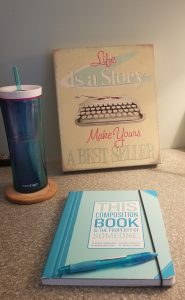
Prefer an app for your to-do lists? Trello is a fantastic app which lets you create endless topics (lists) and tasks (cards).
Start by writing the name of each room in your home on a separate page. The great thing about these lists is that they can be a summer and beyond project…no need to rush it! Next, start your brain dump, where you can write tasks to be done in each room. Write down what comes to mind and add more as you think of it. The tasks should be specific and therefore hopefully less overwhelming. It’s up to you to choose how many tasks you want to complete at a time!
For example:
Master Bedroom Closet Tops
Do you have other things come to mind, that aren’t specific to a room? Write them down too! Getting too much junk mail? Look to catalogchoice.org and optoutprescreen.com. Getting too many spam calls? Try an phone app like, Should I answer?, with a cute little octopus icon, which turns green for a positive call or red, to know instantly if a call has received negative ratings, and block them on your phone! I know, I know, once a company is blocked by using one number, they will move to another, but every little block counts!
Pen and paper or app, the key to dissolving a cluttered mind is to write things down, so that you have space in your brain for more important things to think about, like what flavor of ice cream to get tonight!
While working with clients on managing their paperwork and filing systems, and/or time management/productivity we often come across very old (meaning over a year) TO DO lists.
Are YOU haunted by these? Know they are out there lurking to challenge and shame you? I AM!!!
Here are some thoughts to guide you as you contemplate your next move against these demons.
Option #1: Look at them
Pros:
Cons:
Option #2 Throw them out
Pros:
Cons:
My recommendation:
Take an hour or two off and, armed with a legal pad or journal, bring those lists to a coffee shop/library or other secret hideaway. Review them in a loving, self-accepting way. Jot down any thoughts that arise.
Then, like you would with the old tub of cream cheese that is festering in the back of the frig, growing green and black molds, TOSS the old to do lists out.
Onward to what calls to you NOW!
As a residential professional organizer, I visit lots of homes. One household system that is quick to fall apart and overwhelm a person is LAUNDRY.
I have strong opinions on laundry:
• dark and light clothing should be separated (my children do not all agree)
• “laundry” is not done until it is all put away
You don’t have to share those views, but I see on a weekly basis how the “putting away” is where the system breaks down. Most of us are pretty good starting the laundry process. There is an obvious and inevitable external motivation to wash clothes when one runs out of clean socks or underwear. Many people are also decent at shifting the wet clothes over to the dryer. The widespread access to timers on our phones has made this step particularly easy for even the “follow-through-challenged.”
I see “laundry overwhelm” during the next 2 points in the system:
1) clean but not yet folded clothes that remain clean…until they get mixed with dirty clothes or buried under other stuff
2) folded clothes in baskets — when not returned to dresser drawers or closets they clog bedrooms and hallways and hold laundry baskets hostage creating a problem for dirty clothes who remain “homeless”
If we focus on these 2 connected steps along the process: 1) folding and 2) putting away and employ task batching, the process goes smoother.
Task batching is a way to manage time and perform tasks in sets where the same mental effort and physical energy is used to maximize productivity and streamline a process.
Even if laundry is not the most stressful task, any project you can simplify will free up your mind for the heavy lifting of life. If you’re a procrastinator, my suggestion to task batch your folding and put away steps is good news! It decreases the distance between start and finish and builds in lots of manageable size “loads.” More, but smaller tasks to quickly complete, offer the satisfaction of a job well done!
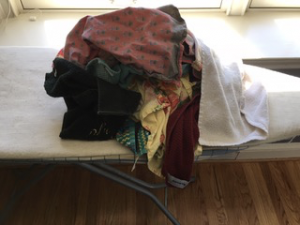
Take this example of table linens – out of the dryer and onto a folding surface.
Task Batched Folding Steps would look like this:
• Sort clean laundry into categories: if you mix loads from a whole household, your first sort job will be by person, then by category of clothing (socks, underwear, shirts that fold, shirts that hang, bottoms, work out clothing, pajamas…etc).

Step 1: sort into categories: this load broke down into hand towels, dish towels and cloth napkins.
• Prep each category so it’s ready to be folded (right any clothes that are inside out or button collars).
• Fold each category separately – meaning one category at a time – preferably on a clean and flat surface.
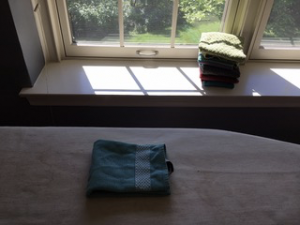
• Do all of your folding at once.

Step 2: fold each mini pile as its own category.
Our cloth napkins need to be ironed so they’ll stay on the ironing board.
The other 2 folded piles will go into their appropriate drawers in the kitchen.
Will task batching your folding process solve all of your laundry dilemma’s? No — but folding by category allows you to delegate small pieces of the project to even the youngest helpers and lets others take pride in the smooth running of the household if you’re lucky enough to live with people who will “volunteer” or as in our household, be volunteered to help 🙂
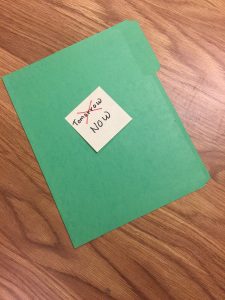 Here are some strategies that can help. The example we’ll use applies them to paper clutter, but they can help you get moving on any clutter-busting project.
Here are some strategies that can help. The example we’ll use applies them to paper clutter, but they can help you get moving on any clutter-busting project.
Often, seeing something concrete will get you moving, especially if you’re a visual person.
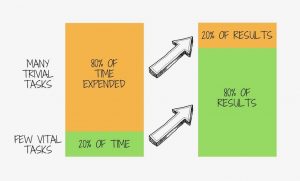 Have you ever gotten to the end of your day wondering what (if anything) of value you actually accomplished? If so, it may be time to pull out the 80/20 Rule!
Have you ever gotten to the end of your day wondering what (if anything) of value you actually accomplished? If so, it may be time to pull out the 80/20 Rule!
Professional organizers often apply the 80/20 Rule (a.k.a., the Pareto Principle or the Law of the Vital Few) to decluttering. For example, in a closet, determine the 20% of clothes you wear 80% of the time, purge the 80% of clothes you seldom or never use, and – voila! – you have space for clothes more like your favorite few.
The principle also applies to time. Most of us accomplish 80% of our best work in just 20% of our time, and fritter away 80% of our time doing…what? The key to really accomplishing our goals, to really making an impact, is to focus on the 20% of things we are really good at.
Determining our best 20% when it comes to clothes is pretty straightforward: pull everything out of the closet and start sorting: things I love (or not), things that fit (or not), things that make me look great (or not), etc.
But how do we determine our best 20% when it comes to work? Claire Diaz-Ortiz, in the book Design Your Day, suggests this similar pull-out-and-sort activity to find out:
First, get two pieces of paper. At the top of one write “Big Wins” and on the other write “Activities.”
On the “Big Wins” paper, list things that you’ve done in the past few years, personally or professionally, that have brought you the greatest joy, that have made you feel most alive, that have made you feel like you were in the sweetest of sweet spots. These could be things that happened just once, or continuing things.
On the “Activities” paper, list absolutely everything you do on a regular basis – fun or not fun, significant or not significant, necessary or unnecessary, whatever. Then sort these items into three categories: Things Only I Can Do, Things Someone Else Can Do, and Things I Should Stop Doing. (It might help to rewrite your activities on a fresh piece of paper with three columns headed with these categories.)
Next, cross-check. Things that appear on both your “Big Wins” list and your “Things Only I Can Do” list are your best 20%!
Now, set priorities:
As Diaz-Ortiz says, “ultimately, this activity is a mind-opening way to see where your time and work is really moving the needle and where you’re just running on the hamster wheel to stay busy.”
Let 2018 be the year where you focus on the few vital tasks that best get you to where you want to be.
80/20 your 2018!
The holidays are upon us! There’s so much to keep track of and so many things to do! How can this wonderfully busy time of year feel less stressful? Make a list! Or several!
I love lists! Just the act of writing a list helps me to feel like I have a clearer direction. A checklist is a concrete tool to help you empty your brain of all the things you need to remember…and then to prioritize them.
There are even more things to do and to remember than usual. I use different lists for each facet of the holidays.
If you like writing lists out on paper, keep one folder or notebook as a central location to record your plans. If you prefer going paperless, keeping documents stored on a computer or in a note-keeping system like Evernote is a convenient way to keep an ongoing record over the years.
The following are types of lists to help you stay better ordered as the activities and tasks fill your schedule:
Menus: Write out a list of the entire meal from appetizers through desserts, including those items being provided by other guests. That way, you have a comprehensive overview of the full meal and can fill in the gaps if there are any. Don’t forget to include drinks, paper products, flowers and table centerpieces.
Shopping list: Go through all the recipes you will be preparing and write out every ingredient into a grocery list. The key here is to write the food items according to sections in the grocery store. It helps dramatically when your list is ordered so you don’t have to revisit different sections of the crowded store.
Tasks: Write out all individual tasks required to prepare for the holidays so you can clearly see the extra demands on your time such as: cleaning the house, decorating, shopping for gifts, wrapping, and mailing gifts (by a designated date).
Holiday cards: Keep a master address list that you can update each year. Many people keep it in a format on their computer to print address labels. I like to sort names according to groups: family, friends, neighbors, co-workers, etc.
Gifts: Keep a list of all gifts you plan to purchase according to each person. In the margin, record the store or online vendor and price. You can plan your shopping route according to the stores listed.
Accessory shopping: While shopping for gifts, there are often other details easily overlooked. Designate a master list for details. For example, as you decorate your house or plan your holiday party, keep one list for all those particulars such as a replacement string of lights, a new set of holiday placemats, etc.
A Final Step
Your Calendar: Look through your lists regularly and write tasks into dates on your calendar in order to keep track of what is being accomplished. Write in your planner in pencil to make easy alterations or use an online calendar to easily move tasks around.
Remember: this is a busy time of year. Everything takes longer than expected. In the end, we may need to let go of a few tasks.
The ultimate goal is not to feel harried by the time the actual day arrives so you can enjoy the celebration with those you love!